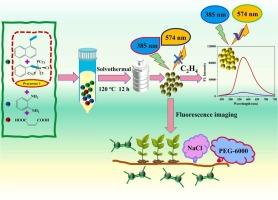利用聚集诱导发射增强的超灵敏碳点纳米荧光探针快速成像非生物胁迫下植物乙烯动态变化
IF 3.7
1区 化学
Q1 CHEMISTRY, ANALYTICAL
引用次数: 0
摘要
开发灵敏可靠的方法,快速原位检测植物在非生物胁迫下释放的痕量乙烯信号,对于破译其复杂的胁迫调节网络至关重要。然而,由于乙烯的生理浓度极低,时空异质性高,缺乏超灵敏的检测工具,这仍然是植物胁迫生理学的持续瓶颈。在此,我们报道了一种智能“开启”荧光碳点(CD)纳米探针(NE-CDs),该探针由1-乙烯基萘和Grubbs催化剂前驱体构成。通过特定乙烯识别触发的聚集诱导发射增强(AIEE)机制,NE-CDs实现了对乙烯的超灵敏响应,检测限(LOD)低至0.036 ppm。与现有的纳米探针相比,这代表了灵敏度的一个数量级提高,能够精确捕获以前无法检测到的乙烯信号的早期或微弱波动。重要的是,NE-CDs成功应用于盐和干旱胁迫下拟南芥叶片内源乙烯释放模式的快速检测、动态成像和监测。本研究不仅提供了一种性能优越的新型纳米探针用于检测痕量乙烯,更重要的是,为快速分析复杂非生物胁迫下乙烯信号的时空动态及其在胁迫适应中的精确调控机制开辟了新的途径。它在推进植物抗逆性机制研究、指导作物抗逆性育种和发展精准农业技术方面具有巨大潜力。本文章由计算机程序翻译,如有差异,请以英文原文为准。

Ultrasensitive carbon dot nanofluorescent probe for rapid imaging of ethylene dynamic changes in plants under abiotic stress exploiting aggregation-induced emission enhancement
Developing sensitive and reliable methods for the rapid, in situ detection of trace ethylene signals released by plants under abiotic stress is crucial for deciphering their complex stress-regulatory networks. However, this has remained a persistent bottleneck in plant stress physiology due to ethylene’s extremely low physiological concentrations, high spatiotemporal heterogeneity, and the lack of ultrasensitive detection tools. Herein, we report an intelligent “turn-on” fluorescent carbon dot (CD) nanoprobe (NE-CDs) constructed from 1-vinylnaphthalene and a Grubbs catalyst precursor. Through an aggregation-induced emission enhancement (AIEE) mechanism triggered by specific ethylene recognition, the NE-CDs achieve an ultrasensitive response to ethylene with a limit of detection (LOD) as low as 0.036 ppm. This represents an order-of-magnitude improvement in sensitivity compared to existing nanoprobes, enabling the precise capture of previously undetectable early or faint fluctuations in ethylene signals. Importantly, the NE-CDs were successfully applied for rapid detection, dynamic imaging and monitoring of endogenous ethylene release patterns in Arabidopsis thaliana leaves under salt and drought stress. This work not only provides a novel nanoprobe with superior performance for trace ethylene detection but, more significantly, paves a new avenue for the rapid analysis of the spatiotemporal dynamics of ethylene signaling under complex abiotic stresses and its precise regulatory mechanisms in stress adaptation. It demonstrates immense potential for advancing research into plant stress resistance mechanisms, guiding crop breeding for stress tolerance, and developing precision agriculture technologies.
求助全文
通过发布文献求助,成功后即可免费获取论文全文。
去求助
来源期刊

Sensors and Actuators B: Chemical
工程技术-电化学
CiteScore
14.60
自引率
11.90%
发文量
1776
审稿时长
3.2 months
期刊介绍:
Sensors & Actuators, B: Chemical is an international journal focused on the research and development of chemical transducers. It covers chemical sensors and biosensors, chemical actuators, and analytical microsystems. The journal is interdisciplinary, aiming to publish original works showcasing substantial advancements beyond the current state of the art in these fields, with practical applicability to solving meaningful analytical problems. Review articles are accepted by invitation from an Editor of the journal.
 求助内容:
求助内容: 应助结果提醒方式:
应助结果提醒方式:


